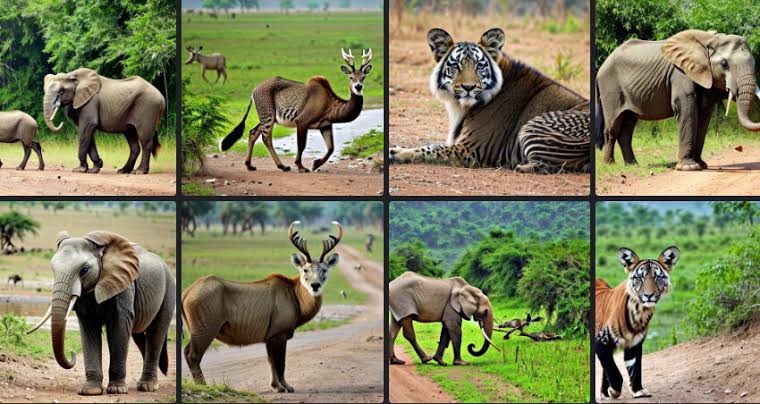The concept of wildlife principles and management encompasses all undomesticated animal and plant species, contributing fundamentally to our planet’s ecosystems and biodiversity. The concept of wildlife is integral to ecological stability, as these species play distinct roles in their respective environments, such as pollinating plants, controlling pest populations, and helping sustain food chains.
Understanding wildlife in a comprehensive sense includes acknowledging its biodiversity, its roles, and the ecosystems it upholds. As human societies expand, interactions with wildlife become more frequent, raising the importance of managing these interactions sustainably.
The principle of wildlife management has become crucial to ensure that these natural assets continue to thrive for ecological balance and human benefit. Wildlife management principles emphasize creating sustainable practices that enable the coexistence of humans and wildlife without compromising natural habitats or biodiversity.
A fundamental goal within the concept of wildlife management is conserving ecosystems and the species they harbor while allowing for human activities that depend on these resources. To achieve this balance, wildlife management uses a blend of scientific research, policy-making, and ethical considerations.
It requires a detailed understanding of animal behavior, habitats, and ecological requirements, alongside the social and economic factors that impact wildlife. This approach incorporates various methodologies, from population control and habitat preservation to legislative frameworks aimed at protecting endangered species and promoting biodiversity.
The economic value of wildlife is a significant component in wildlife management, reflecting the vast array of benefits that ecosystems provide to human societies. Wildlife contributes economically through tourism, ecosystem services, and even as a source of food and raw materials. F
or example, nature-based tourism has flourished worldwide, with national parks and reserves drawing millions of visitors annually, creating jobs and generating revenue for conservation projects.
Studies highlight the economic importance of wildlife by quantifying these benefits, and numerous documents, including the economic importance of wildlife pdf resources, detail the specific financial contributions and challenges associated with wildlife management. These analyses underscore the need for sound management practices to prevent the degradation of valuable natural resources.
Among the core principles of wildlife management is the need for sustainability, focusing on long-term strategies that ensure wildlife resources are maintained for future generations. This principle is implemented through practices like regulating hunting, controlling invasive species, and establishing protected areas to ensure wildlife populations remain stable.
Wildlife management also recognizes the importance of genetic diversity within species, essential for their adaptability and survival, especially amid climate changes and human-induced pressures.
Strategies outlined in various principle of wildlife management texts advocate for measures that limit the encroachment of human activity into wild habitats, thereby reducing conflicts between human and animal populations.
The concept of wildlife management is closely tied to ecological knowledge, involving a scientific understanding of how different species interact within ecosystems and how human activity impacts these relationships.
Wildlife management principles highlight the importance of research and monitoring, as they provide critical data to inform decisions on species protection and habitat preservation. For example, studies on migration patterns, breeding cycles, and feeding behaviors allow conservationists to make informed choices that support biodiversity.
In applying these principles, wildlife managers use data-driven approaches, often summarized in principles of wildlife management pdf resources, that help develop targeted interventions for endangered or at-risk species.
One of the significant challenges in wildlife management is balancing conservation efforts with the economic demands that often impact wildlife habitats. Agriculture, infrastructure development, and urban expansion frequently encroach upon natural ecosystems, leading to habitat fragmentation and biodiversity loss.
To address these issues, wildlife management integrates economic considerations to advocate for sustainable practices that benefit both nature and local communities. Resources like the economic importance of wildlife pdf offer insights into the economic arguments for conservation, emphasizing how preserving ecosystems ultimately benefits societies by providing clean water, air, and fertile soil.
Incorporating economic value into wildlife management is crucial for demonstrating the benefits of conservation to policymakers and stakeholders. Highlighting the economic value of wildlife encourages investment in conservation efforts and promotes policies that safeguard biodiversity.
By showing how ecosystems contribute to sectors like agriculture, pharmaceuticals, and tourism, wildlife advocates can build support for sustainable practices. For instance, pollinators like bees play a vital role in food production, supporting agriculture worth billions of dollars globally.
Recognizing these economic values and incorporating them into wildlife management strategies reinforces the interconnectedness of human well-being and biodiversity. Wildlife management principles also address the social dimensions of conservation.
Community involvement and education are vital for fostering a sense of responsibility toward wildlife. Many principles of wildlife management underscore the need for local communities to actively participate in conservation efforts, as their traditional knowledge and daily interactions with ecosystems provide valuable insights.
Programs that engage communities in protecting local species or preserving habitats help build awareness of wildlife’s economic and ecological roles. Additionally, community-based initiatives can lead to sustainable livelihoods through eco-tourism or wildlife-related enterprises, reducing pressure on natural resources.
A guiding concept of wildlife management is adaptability, which acknowledges the ever-changing dynamics of ecosystems and the need to adjust management strategies accordingly. Changes in climate, species migration, and habitat availability mean that wildlife management cannot be static.
Wildlife management principles emphasize adaptive management, where policies are continuously revised based on new data and environmental conditions. For example, if a species’ population is found to be declining due to habitat loss, conservationists might work to restore those habitats or establish protected corridors that facilitate migration.
By being adaptable, wildlife management remains relevant and responsive to emerging challenges. The global nature of environmental challenges also necessitates cooperation among nations, as wildlife often crosses borders and ecosystems are interconnected.
International treaties and agreements play a significant role in wildlife management, especially for migratory species and biodiversity conservation on a broader scale. Collaborative efforts among countries allow for the sharing of resources, data, and expertise, which strengthens conservation initiatives and reinforces global commitments to biodiversity.
Read Also: Health Benefits of Lady Finger
Economic Importance of Wildlife Concept and Management

Wildlife holds profound economic importance, playing a central role in ecosystems worldwide and delivering benefits that ripple through local and global economies. The concept of wildlife encompasses not only the animals and plants in natural environments but also the intricate web of relationships they share with their surroundings.
This interconnectedness highlights why conservation and management are essential for maintaining the delicate balance that sustains our world’s natural resources. Wildlife, in this context, refers to all undomesticated organisms existing in the wild, from mammals and birds to plants and microorganisms, each contributing uniquely to ecological and economic health.
One major economic advantage of wildlife is its ability to drive tourism, an industry that supports jobs, generates revenue, and improves infrastructure. Ecotourism, which depends on the concept of wildlife, thrives in locations where visitors can observe and appreciate animals in their natural habitats.
National parks, wildlife reserves, and marine sanctuaries often rely on the attraction of these diverse species to draw tourists from around the world. In countries where unique ecosystems are a primary attraction, tourism income can represent a significant portion of the national economy, thus linking wildlife directly to financial stability and growth.
Additionally, wildlife plays an indirect economic role by providing ecosystem services—benefits that human populations receive simply because wildlife and nature function as they should. Pollination, seed dispersal, and pest control are examples of these services.
Through the concept of wildlife, many species contribute to agriculture. Pollinators like bees and butterflies, for instance, help produce fruits, vegetables, and other crops essential for human consumption and commerce.
Similarly, pest control by predators like birds and bats reduces the need for chemical pesticides, which can be expensive and harmful to human health and the environment. The concept of wildlife further reveals that many plants and animals serve as sources for medicines and medical research.
A significant percentage of modern medicines are derived from compounds found in wild species. For example, species found in rainforests and other biodiverse areas offer potential treatments for diseases and new pharmaceuticals.
The search for medicinal resources has economic benefits, fueling industries and inspiring further research into wildlife’s therapeutic potential. As natural habitats diminish, however, many species are lost, which can mean the disappearance of unknown medical solutions and resources that could have held considerable economic value.
Forestry and fisheries are also important economic sectors impacted by wildlife. Forests host a wide range of biodiversity, with numerous tree species providing wood, fibers, and other products that sustain various industries.
Similarly, the health of fisheries depends on maintaining balanced marine ecosystems, where wildlife diversity is key to sustainable harvests. Understanding the concept of wildlife emphasizes the need for sustainable management, ensuring that resources can be used over the long term without depleting them or causing environmental degradation.
When managed responsibly, wildlife resources such as forests and fisheries contribute consistently to economic prosperity. Additionally, maintaining wildlife populations can prevent potential economic losses. Healthy ecosystems act as natural buffers against environmental threats such as floods, droughts, and soil erosion.
Wetlands, for example, absorb excess water, reducing the impact of flooding. Forests stabilize soils and help maintain water cycles, which protect agriculture and reduce the need for costly human interventions.
By supporting these ecosystems, the concept of wildlife ensures that natural processes work in our favor, ultimately reducing the financial burden of disaster recovery and other environmental challenges.
Local communities also directly benefit economically from wildlife through sustainable practices. In many areas, the sustainable harvest of forest products—such as nuts, fruits, and medicinal plants—provides income for local populations.
Community-based conservation initiatives support both wildlife and people, creating jobs, generating income, and fostering community involvement in preserving natural resources.
Through wildlife conservation programs, community-led tourism, and sustainable resource use, the concept of wildlife promotes self-sufficiency and financial resilience, especially in rural and indigenous populations. The economic value of wildlife also extends to agricultural and livestock support.
Biodiversity contributes to genetic diversity, which helps crops and livestock resist diseases and adapt to environmental changes. Wild relatives of domesticated plants and animals contain genetic traits that can be used to improve resilience in agriculture, enhancing food security and reducing losses due to pests or climate variability.
This aspect of the concept of wildlife has far-reaching effects, as food security is essential for economic stability and growth, especially in regions heavily dependent on agriculture. Wildlife also plays a role in regulating and maintaining the health of ecosystems by keeping population numbers balanced.
Predators control herbivore populations, preventing overgrazing and maintaining the productivity of grasslands and forests. This balance is part of the concept of wildlife and contributes to the long-term sustainability of resources, ensuring that habitats remain viable for the benefit of future generations.
The ongoing health and balance of ecosystems have intrinsic economic value, as they support renewable resources that can be harvested and used sustainably. Moreover, the concept of wildlife highlights the aesthetic and cultural importance that many societies place on nature, which often translates into economic gains.
Art, literature, festivals, and other cultural expressions are influenced by wildlife, attracting tourists and supporting creative industries. Wildlife-related activities, whether through nature photography, birdwatching, or cultural festivals celebrating local biodiversity, contribute to both economic and cultural enrichment, reinforcing the strong connection between human identity and nature.
Read Also: Benefits of Nunum Leaves
Objectives of the Concept of Wildlife and Its Management

1. Conserving Biodiversity: A core objective of the concept of wildlife and its management is to conserve biodiversity by protecting various species and their habitats. The preservation of genetic, species, and ecosystem diversity within a given area ensures the resilience of natural systems. High biodiversity levels contribute to ecosystem health, as each species plays a unique role within its habitat.
By conserving wildlife diversity, management practices help maintain food chains, nutrient cycles, and overall ecological stability. Protecting biodiversity ultimately reduces the risk of species extinction and fosters a balanced environment that benefits all forms of life.
2. Maintaining Ecological Balance: Ecological balance is essential for the sustainable functioning of ecosystems, and a primary goal of wildlife management is to preserve this balance. Predators, herbivores, and other species interact within their environments to create stable systems, where population numbers are regulated naturally.
For example, predators control the populations of herbivores, preventing overgrazing and ecosystem degradation. Wildlife management practices aim to maintain these natural interactions to prevent species overpopulation or decline, which could disrupt the entire ecosystem. Through regulated hunting, habitat protection, and conservation efforts, wildlife managers work to sustain balanced, healthy ecosystems.
3. Supporting Sustainable Resource Use: The concept of wildlife and its management emphasizes the sustainable use of wildlife resources to benefit human populations without compromising the needs of future generations.
This objective ensures that resources such as fish, timber, medicinal plants, and other wildlife-derived materials are harvested in ways that allow ecosystems to regenerate and sustain these resources over time.
Sustainable wildlife use is especially critical in rural and indigenous communities, where people rely on natural resources for livelihoods and cultural practices. By implementing quotas, breeding programs, and habitat restoration, wildlife managers can meet human demands while preserving wildlife populations.
4. Protecting Endangered Species: Endangered species require specialized protection due to their vulnerable population status and risk of extinction. Wildlife management aims to stabilize or increase the populations of these species through targeted conservation strategies. Efforts may include captive breeding programs, reintroduction into native habitats, habitat restoration, and the enforcement of legal protections.
The ultimate goal is to bring these species back to a self-sustaining level within their natural ecosystems, contributing to biodiversity and ecological balance. In many cases, protecting endangered species also aids in conserving the entire ecosystem, as these species often play critical ecological roles.
5. Enhancing Human-Wildlife Coexistence: Human activities such as agriculture, urban development, and industrialization have led to conflicts between humans and wildlife. A significant objective within the concept of wildlife and its management is to promote peaceful coexistence by minimizing these conflicts.
Strategies include developing buffer zones, implementing non-lethal deterrents, and creating policies that protect both human interests and wildlife. Wildlife corridors and conservation areas are designed to give animals access to their natural ranges, reducing human-wildlife conflicts such as crop raids or livestock predation. By fostering coexistence, wildlife management supports community livelihoods and reduces negative impacts on wildlife.
6. Enhancing Ecotourism and Education: Ecotourism, an industry heavily dependent on wildlife, contributes significantly to local and national economies. The concept of wildlife and its management includes developing and supporting ecotourism activities that generate revenue while promoting conservation.
By providing guided wildlife experiences in protected areas, communities can benefit economically from tourism, which in turn creates financial incentives for conservation.
Additionally, educational programs integrated into ecotourism raise awareness about the importance of wildlife, fostering a culture of conservation among visitors. Responsible ecotourism promotes a sustainable connection between people and nature, benefiting both wildlife conservation and economic growth.
7. Restoring and Managing Habitats: Habitat restoration is essential for wildlife conservation, as many species are losing their natural environments to deforestation, pollution, and climate change. Wildlife management involves rehabilitating degraded areas to provide suitable habitats for wildlife populations.
Restoration efforts may include reforestation, controlling invasive species, and improving water sources. By restoring habitats, wildlife managers help reestablish conditions in which species can thrive. Habitat management also considers factors like seasonal migrations and breeding grounds, ensuring that animals have access to essential resources throughout their life cycles.
8. Promoting Ecosystem Services: The concept of wildlife and its management recognizes the importance of ecosystem services—benefits that natural ecosystems provide to human societies.
Services like pollination, pest control, water purification, and climate regulation are essential for agriculture, human health, and environmental stability. Wildlife management protects these ecosystem services by preserving habitats and species that perform crucial ecological functions. For instance, insect and bird species play a role in pollination, while predators control pests that could damage crops. By maintaining biodiversity, wildlife management ensures that ecosystems continue providing these invaluable services.
9. Conducting Scientific Research and Monitoring: Scientific research and monitoring are critical to effective wildlife management, as they provide data on species populations, habitat conditions, and ecosystem health. Continuous research informs management practices, helping wildlife managers adapt to new challenges and refine conservation strategies.
Monitoring programs track trends in wildlife populations and habitat quality, identifying potential threats such as climate change, disease outbreaks, and habitat degradation. The concept of wildlife and its management relies on this data-driven approach to make informed decisions, implement effective measures, and adjust policies as necessary to protect wildlife resources.
10. Supporting Legal Frameworks and Policies: Wildlife management operates within the scope of national and international laws aimed at protecting wildlife resources. Policies such as hunting regulations, protected area designations, and international treaties are essential to wildlife conservation efforts.
One of the objectives of wildlife and its management is to support these legal frameworks, ensuring that laws are enforced and adhered to by all stakeholders. Legal protections help prevent illegal activities such as poaching, habitat destruction, and trafficking of endangered species.
By working alongside governments, conservation organizations, and communities, wildlife managers ensure that legal protections support wildlife conservation goals.
11. Addressing Climate Change Impacts on Wildlife: The concept of wildlife and its management also includes addressing the impacts of climate change on wildlife populations and habitats. Climate change alters temperature patterns, food availability, and migration routes, affecting the survival of many species.
Wildlife management aims to build ecosystem resilience by protecting habitats, facilitating species adaptation, and monitoring climate-related shifts. For instance, creating climate corridors helps species move to more favorable habitats as conditions change. Wildlife management strategies are increasingly focused on mitigating climate change’s effects to preserve biodiversity and ensure ecosystem stability.
Frequently Asked Questions on the Concept of Wildlife Principles and Management

1. What is the concept of wildlife and its management?
The concept of wildlife and its management involves the stewardship of wild animal species and their habitats to ensure their conservation, sustainable use, and ecological balance.
This concept includes a variety of strategies, from habitat preservation and population control to legal regulations, all aimed at promoting biodiversity and enabling humans and wildlife to coexist harmoniously.
2. Why are wildlife management principles important?
Wildlife management principles provide a framework to ensure the health and sustainability of ecosystems. They guide the development of strategies that balance conservation goals with human needs, addressing biodiversity preservation, species protection, habitat restoration, and conflict reduction. These principles help protect ecological integrity, ensuring that natural resources are available for future generations.
3. What are the core principles of wildlife management?
The principles of wildlife management include preserving biodiversity, supporting sustainable use of wildlife resources, ensuring ecosystem stability, and protecting endangered species.
Additionally, wildlife management focuses on restoring and maintaining habitats, reducing human-wildlife conflicts, and promoting scientific research and education. By following these principles, wildlife managers can make informed decisions to achieve conservation goals.
4. How does wildlife management benefit the economy?
The economic importance of wildlife management is significant, as it supports industries such as ecotourism, recreation, and sustainable hunting. Wildlife contributes to local and national economies through tourism, creating jobs and generating revenue.
Proper management also ensures that wildlife resources, such as fish and plants, are sustainably harvested, providing long-term economic benefits for communities that rely on them.
5. How does habitat restoration fit into wildlife management?
Habitat restoration is a critical aspect of wildlife management, as many species depend on specific environments to survive. Restoration efforts include reforestation, controlling invasive species, and protecting water sources to improve habitat quality. By restoring habitats, wildlife management creates suitable conditions for species to thrive, helping maintain biodiversity and ecological balance.
6. What role does scientific research play in wildlife management?
Scientific research is essential in wildlife management, as it provides data on species populations, ecosystem health, and environmental threats. Ongoing research helps wildlife managers understand changing conditions, develop new conservation strategies, and monitor the effectiveness of current practices. Informed by research, management decisions can be adapted to address emerging challenges such as climate change and habitat loss.
7. How do wildlife management principles address human-wildlife conflicts?
Human-wildlife conflicts, such as crop damage and livestock predation, are managed through principles that promote coexistence. Strategies may include establishing buffer zones, developing deterrents, and creating policies that protect both human and wildlife interests.
Wildlife corridors and conservation areas help reduce interactions between humans and wildlife, allowing for peaceful coexistence and reducing negative impacts on both sides.
8. How does the concept of wildlife and its management address climate change impacts?
Wildlife management principles increasingly focus on climate change’s effects on ecosystems and species. By enhancing habitat resilience, protecting migration routes, and restoring ecosystems, wildlife management helps species adapt to changing conditions. Through these adaptive strategies, managers work to preserve biodiversity and maintain ecological balance in the face of climate change.
Read Also: Healthiest Starbucks Drinks To Add To Your Diet
Do you have any questions, suggestions, or contributions? If so, please feel free to use the comment box below to share your thoughts. We also encourage you to kindly share this information with others who might benefit from it. Since we can’t reach everyone at once, we truly appreciate your help in spreading the word. Thank you so much for your support and for sharing!

